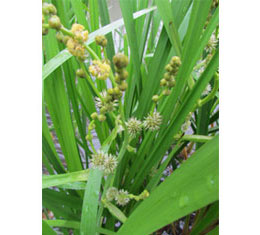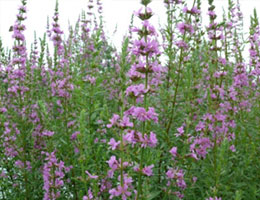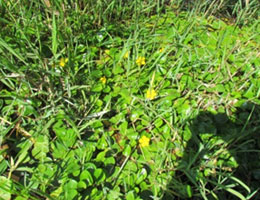
Aquatic Plants

- Wetland plants
- grow at river edges, in wetlands, etc.
- Helophytes
- plants rooted in the bottom, but with leaves above the waterline
- Nymphaeids
- plants rooted in the bottom, but with leaves floating on the water surface
- Pleuston
- vascular plants that float freely in the water
- Submerged plants
- complete their entire lifecycle underwater
Aquatic plants include both those that live at the water's edge and those that live in the water. Their habitats are "ecotones"--transition areas between two biomes, such as shores,
grasslands, and forests—where great diversity of plantlife can be found. Aquatic plants offer birds and fish food and places to lay their eggs and rear their young, playing the role of
mediator to harmonize various animal species. However, in addition to the destruction of ecotones as a result of coastal and shoreline development, farms and sewers degrade water quality,
and highly fertile alien species invade habitats, placing many species of aquatic plants in danger.
In Advantest's biotope, aquatic plants play an important role in preserving biodiversity, and we are committed to encouraging and reintroducing them where needed.
Aquatic Plants of the Biotope
- Knotweed (Persicaria perfoliata)
-
Wetlands plant
Flowers in July-October
Its sharp thorned vines grow entwined with other plants. After its light-green flowers bloom, it produces fruits of a brilliant deep blue.

- Dayflower (Aneilema keisak)
-
Wetlands / Helophyte
Flowers in August-October
We haven't seen dayflower in the biotope for the past few years, but were able to confirm its presence for the first time in many years in 2015. Where we found it, we had previously been excavating to draw the water, so we think old seeds must have germinated where the soil was turned over by drilling. Its Japanese name of Ibokusa comes from the folk belief that warts (ibo) can be removed by the juice of its leaves .

- Cattail (Typha latifolia)
-
Helophyte
Flowers in June-August
From rhizomes buried in the mud, cattails grow to about the size of an adult human being. Like the heads of barley and pampas grass, the cattail's many small flowers form distinctive spikes.

- Japanese parsley (Oenanthe javanica)
-
Wetland / Helophyte
Flowers in July-August
As one of the "seven herbs of spring," it has edible shoots, but caution is advised as there is a poisonous parsley very similar in appearance. In summer, it shoots up and puts forth white flowers.

- Burr-reed (Sparganium erectum)
-
Helophyte
Flowers in May-August
Status: Quasi- endangered species (Japanese Ministry of the Environment)
Its fruits are spiky like burrs or chestnut casings. The burr-reed is classified as being in danger of extinction, but the biotope has many native examples. Even those that were planted at the beginning of construction 15 years ago are still healthy.

- Mizokoju (Salvia plebeian)
-
Wetlands
Flowers in May-June
Status: Quasi- endangered species (Japanese Ministry of the Environment), quasi-endangered species (Gunma Prefecture)
Mizokoju flowers from germination, and is a biennial plant with a two-year lifecycle, so its appearance changes almost every other year. We have seen fewer in 2016. It is a quasi- endangered species, but is found even in the runoff ditches around the biotope.

- Mizosoba (Persicaria thunbergii)
-
Wetlands
Flowers in July-October
It is seen in the ditches around paddy fields, and seems to have got its name because its flowers are similar to those of buckwheat (soba in Japanese). Several flowers bloom together on the tips of the stems.

- Purple Loosestrife (Lythrum anceps)
-
Wetlands
Flowers in July-August
This perennial grows in fields and mountains and wetlands. Its Japanese name of misohagi comes from the fact that it is used in the misogi ceremony (a Shinto ceremony of ritual purification that involves washing the entire body), and is said to resemble the hagi plant (Japanese bush clover).

- Mikoshigaya (Carex neurocarpa)
-
Wetlands
Flowers in May-June
Status: Quasi- endangered species (Gunma Prefecture)
Though classified as quasi-endangered in Gunma Prefecture, many mikoshigaya can be seen in the biotope. The portion that looks like a flower is actually an ear. This is a feature of the Cyperaceae and Gramineae plant families.

- Water Pepper (Persicaria hydropiper)
-
Wetlands
Flowers in July-October
Try nibbling on the leaves: they are fiery! At first, we only saw water pepper in the stream in the biotope, but recently it has also been spotted near the pond. Its seeds must have been washed down there.

- Common Reed (Phragmites australis)
-
Helophyte
Flowers in August-October
In Japan, reeds are used to make window blinds. Even today they are often seen in wetlands and on riverbanks. Reeds provide a habitat and refuge to many creatures, such as birds, and play an important role in terms of biodiversity.

Floating Heart Relocation Project
The floating heart plants in Advantest's biotope come from the Oido river basin of Isesaki, Gunma Prefecture. When an improvement project was implemented in 2012, part of the floating heart
population there was evacuated, and the biotope was selected as one of three places where it was relocated.
More than ten years have passed since Advantest 's biotope opened in 2001, and the environment has stabilized, with the number of species of plants showing no significant change. Our
selection as a refuge for these floating heart plants proves the effectiveness of the maintenance and management system we have established through experience.


Growing a Floating Heart Patch in the Biotope

Seedlings of floating heart. They are tied around a stone so that they would not be washed away in the water.

Planting the floating heart seedlings

After planting. The addition of black soil to encourage growth has darkened the water a little.

In the winter the leaves wither entirely and the plant seems to vanish, but floating heart is a perennial. Its roots live through the winter.

Sometimes alien species may appear in the planting area and inhibit the growth of floating heart. This winter, we removed water speedwell from the area.

In April, small leaves of floating heart start to appear on the surface of the water.

June to August is floating heart's flowering period. It spreads out its leaves to compete with other plants which do the same, almost hiding the surface of the water.

We will endeavor to preserve and nourish floating heart in the biotope so that these pretty yellow flowers will be seen in every summer to come.
Local Schoolchildren Help to Eliminate Invasive Crayfish From the Biotope
As one of our CSR activities here at the Gunma R&D Center, we invite local schoolchildren to visit the biotope. This June 9th, 57 second-graders from West Meiwa Elementary School in nearby
Meiwa-machi came to see the pond and help us catch American crayfish—an invasive species. Formerly, the children would catch two or three crayfish on these expeditions, but last year and
this year not a single crayfish was to be found. The children were disappointed, but this shows that our efforts to encourage biodiversity in the biotope are working!
The photo below on the right shows the crayfish we caught ourselves on the morning of the event to use as a teaching prop. The children took it back to school to put in their class aquarium,
where it continues its career as a teaching prop in science classes.



Vocational School Students Visit the Biotope for Field Training
On June 10th, seven students from The Botanical College of Technological Horticulture in Gyoda City came to visit the biotope. These students aspire to careers as specialists in landscaping
and the 're-greening' of the environment. Their field trip to the biotope was planned as an activity to acquaint them with the biotope concept, which may be useful in their future
careers.
They first took a tour of the biotope, then learned about the landscaping and gardening work we do here, and finally separated to make closer observations of the things that caught their
interest. We hope this visit has planted some seeds that will lead them to work for biodiversity in their future careers as professionals.




